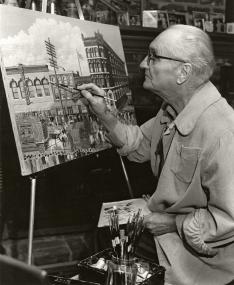
|
Second Floor Hours
865-215-8824, eths@eastTNhistory.org |
First Floor Hours
865-215-8830 |
Third Floor Hours
865-215-8801 |
Second Floor Hours
865-215-8800 |

Russell Briscoe, 1899-1979
Home is where the heart is . . .
“Russell Briscoe’s paintings reflect the work of both historian and artist. His attention to detail and accuracy and his use of color give us a very special and unique glimpse of our area’s past.” – Steve Cotham, manager of the Calvin M. McClung Historical Collection, Knox County Public Library
Welcome to the Russell Briscoe art collection, a legacy for generations. The artist produced 75 known paintings in 22 years, from about 1957 when he began to paint seriously until his death in 1979. Images of Home and Heritage records 70 of the paintings.
Briscoe’s paintings capture the spirit of times long past. They are visual history that spans 189 years of life in Knoxville and East Tennessee. The collected works depict landmarks and events, both public and private, from Smoky Mountains to Gay Street, from battlegrounds to churchyards, from trolleys to trains. Minute details, meticulously drawn, show a draftsman’s hand. Painstaking brushstrokes, applied in vivid colors, reveal a heart deeply connected to home and heritage.
His work is respected among artists for its skillful execution, and among scholars for its historical accuracy.
Positive Reviews
Briscoe’s collected paintings were exhibited only once in his lifetime. In April 1972, the University of Tennessee Department of Art exhibit featured 25 Briscoe originals in McClung Museum Gallery. The work was warmly received and lauded for its artistic merit. Exhibits after his death sponsored by the Dulin Gallery and by the Knoxville Museum of Art (KMA) elicited more excitement for the Briscoe collection.
Arts and antiques columnist Joe Rosson wrote a review of the 1987 KMA exhibit, A View of His City: Paintings by Russell Briscoe. His words eloquently summarize Briscoe’s art.
Briscoe’s paintings present a personal view of local history as seen through the rainbow tinted glasses of nostalgic adulthood. From this perspective, Knoxville is a beautiful place full of trains, trolley cars and turbulent street scenes that gladden the heart and lift the spirits while they instruct us on the particulars of our past.
Only in the depiction of the Civil War battle scenes do we see the gray, ominous cloud of conflict obscuring the artist’s otherwise sunlit summary of Knoxville’s earlier days. In Briscoe’s hands, even an event like the Gay Street fire of 1897 reverberates with positive values such as excitement and heroism rather than terror and tragedy.
Beginnings
Briscoe began painting in earnest in 1957 when his wife, Deas, gave him oil paints and brushes for his 57th birthday. He set up his easel in the corner of the family room at home.
Briscoe was faithful to historical records, including photographs and postcards, and his own careful observations of existing historic sites. But his inspiration came from deeper resources—memories of a happy childhood and his favorite family stories.
He was born on November 5, 1899, and reared in the historic Fort Sanders neighborhood near the University of Tennessee, close to extended family, close to historic downtown Knoxville, and close to the train stations that fascinated him.
Triumphs and a Singular Tragedy
Briscoe joined the Marines in WW I. While stationed in Washington D.C. he met Deas Adams. They married in 1923. A son, Russell Briscoe Jr., was born in 1925. A daughter, Peggy, was born in 1929. The family made their home on Terrace Avenue in Knoxville, near the University of Tennessee.
During the Great Depression in the 1930’s, Russell and Deas started a successful wooden toy company from their home and named it Bristoy. At the same time, Briscoe worked for J.E. Lutz Insurance Company. He rose to executive vice president in the firm. Over his long business career, he was a board member for several enterprises, notably Southern Railway’s Cincinnati, New Orleans, & Texas Pacific division and the Knoxville Utilities Board of Commissioners. Civic and cultural organizations continuously sought him out to hold leadership positions.
Tragically, in 1950, Air Force pilot Russell Briscoe Jr. was killed flying a combat mission at the start of the Korean War.
Final Triumphs
In the mid 1960’s, Russell and Deas designed and moved into a new home on Cherokee Boulevard in Sequoyah Hills. By then, their daughter, Peggy, had married Robert Rochelle, a scientist for NASA, and lived in Maryland.
Briscoe retired from J.E. Lutz in 1971. More and more often he was invited to lecture at community meetings on the history of Knoxville represented in his paintings.
He continued painting until the day of his death. In the early morning hours of January 18, 1979, after signing his last painting, Russell Briscoe suffered a fatal heart attack. He was interred in Old Gray Cemetery on Broadway in Knoxville. Deas died in 1995 and her grave is beside his. Daughter Peggy died in 2005.
Joe Rosson’s 1987 review gave voice to a special dimension of Briscoe’s artistic achievement.
Briscoe’s paintings are a compilation of childhood memories, exhaustive research, imagination and yes, wishful thinking. Many close observers will notice that all the overhead transmission lines in his pictures seem to vanish into thin air after running only a few inches from the poles.
This, I believe, is wish fulfillment on the part of the artist. If he had his way, such signs of an advancing modern civilization would vanish from Earth altogether, and we would be left with circus parades, ice cream parlors and gentle memories forever.















